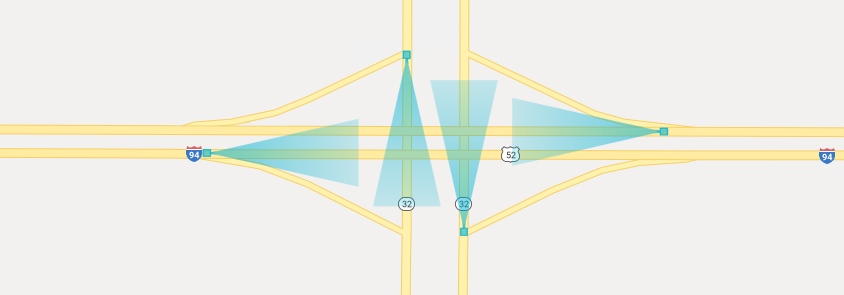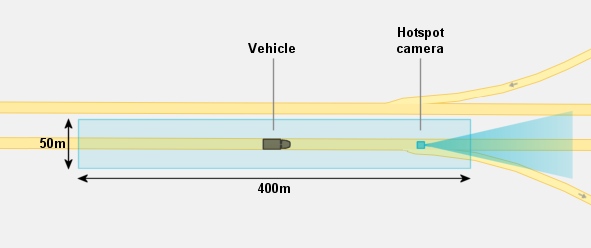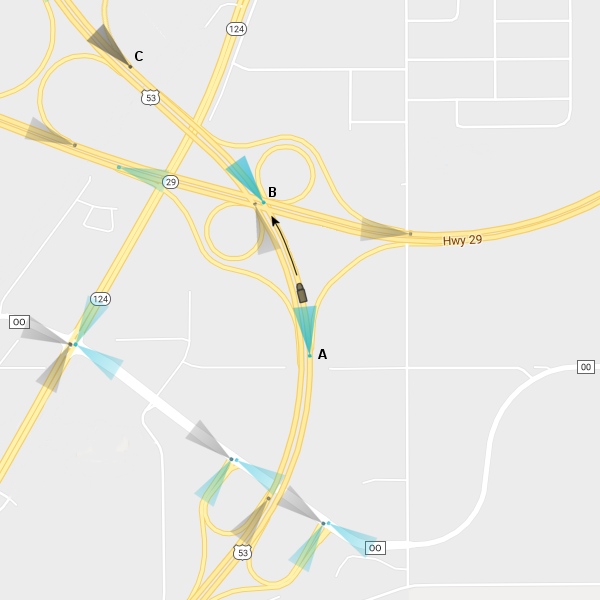Hotspot Cameras
Vizzion's camera coverage includes both roadside cameras and on-vehicle cameras. Images from these on-vehicle cameras can be retrived either from arbitrary locations as Drive Streams, or from fixed locations and headings in the road network, known as "hotspot cameras".

Example of 4 hotspot cameras at an interchange
Requesting Hotspot Images
Before an application can request an image from a hotspot camera, the application must first retrieve all cameras in a particular area using a method such as GetCamerasInBox, or GetCamerasOnRoute. Assuming your license key includes hotspot cameras, both fixed cameras and hotspot cameras will be returned from these methods. Any returned hotspot cameras will include the Hotspot field, set to True. If only hotspot cameras are required, then the “hotspots only” option (option 16) can be used when calling these methods. Each camera returned (both fixed and hotspot cameras) will include a unique camera identifier in the CameraID field. This camera identifier can be used by the GetCameraImage method to request an image from the camera.
Each returned hotspot camera is guaranteed to return an image for at least 15 minutes. For this reason, the application should refresh the camera data every 15 minutes to ensure all hotspot cameras will return images (see Automatic Camera Data Refresh).
Submitting Hotspot Images
Images from on-vehicle cameras are submitted at hotspot camera locations. To submit an image, a vehicle should have a speed of at least 10 kph, should be travelling along a similar heading to any hotspot cameras, and any hotspot cameras should fall within a 400m x 50m box surrounding the vehicle (illustrated below).

Vehicle location and heading compatible with hotspot camera
To submit an image, first retrieve all the hotspot cameras in the area using the GetCamerasInBox method with the “hotspots only” option (option 16). Then, submit an image with the SubmitImage method.
A fresh hotspot camera is a hotspot camera that has recently had an image submitted by an on-vehicle camera, and so does not require another image for the next 5 minutes. By keeping track of these fresh hotspot cameras, unnecessary image submissions (and bandwidth) can be avoided.

Fresh hotspot cameras (blue) and hotspot cameras that require an image (grey)
in the vicinity of the vehicle.
In the above illustration, a vehicle has just submitted an image for hotspot camera A, which is now fresh. Hotspot camera B is already fresh, so the vehicle should not submit an image for this location. Hotspot camera C is not fresh, so the vehicle can submit an image for this location.
Pseudocode for an algorithm to submit images from a fleet of vehicles is shown below. Contact support@vizzion.com for sample C# source code for this algorithm.
| Pseudocode |
|---|
Call GetCamerasInBox with “Hotspots Only” option and store Hotspot Cameras For Each Vehicle If speed <= 10kph, Try next Vehicle For Each Hotspot Camera If Hotspot Camera is already fresh, Try next Hotspot Camera If Hotspot Camera heading is not similar to Vehicle heading, Try next Hotspot Camera If Hotspot Camera is not within 400m x 50m box around Vehicle, Try next Hotspot Camera Get image from On-Vehicle Camera Call SubmitImage (can call from async thread to improve throughput) Try next Vehicle |